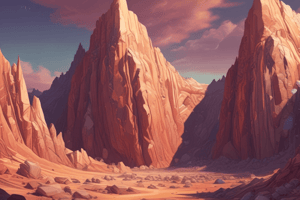Podcast
Questions and Answers
What is the primary difference between intrusive and extrusive igneous rocks?
What is the primary difference between intrusive and extrusive igneous rocks?
- Mineral composition
- Texture
- Location of formation (correct)
- Color
What type of sedimentary rock is formed from the accumulation of plant and animal remains?
What type of sedimentary rock is formed from the accumulation of plant and animal remains?
- Chemical sedimentary rock
- Clastic sedimentary rock
- Metamorphic rock
- Organic sedimentary rock (correct)
What is the term for the movement of the Earth's lithosphere that drives geological activity?
What is the term for the movement of the Earth's lithosphere that drives geological activity?
- Plate tectonics (correct)
- Metamorphism
- Erosion
- Weathering
What is the term for the pattern of breaking along flat surfaces of a mineral?
What is the term for the pattern of breaking along flat surfaces of a mineral?
What is the term for the alteration of existing rocks under high pressure and temperature conditions?
What is the term for the alteration of existing rocks under high pressure and temperature conditions?
What is the term for the breakdown of rocks into sediments through exposure to wind, water, and temperature fluctuations?
What is the term for the breakdown of rocks into sediments through exposure to wind, water, and temperature fluctuations?
Flashcards are hidden until you start studying
Study Notes
Igneous Rocks
- Formed from the cooling and solidification of magma or lava
- Can be either intrusive (forms below the Earth's surface) or extrusive (forms above the Earth's surface)
- Characteristics:
- Coarse-grained texture (intrusive)
- Fine-grained texture (extrusive)
- May contain gas bubbles or mineral crystals
- Examples:
- Granite (intrusive)
- Basalt (extrusive)
Sedimentary Rocks
- Formed from the accumulation and compression of sediments, such as mineral and rock fragments, plant and animal remains, and precipitated minerals
- Can be further divided into three categories:
- Clastic sedimentary rocks: formed from clastic sediments, such as sandstone and conglomerate
- Chemical sedimentary rocks: formed from the precipitation of minerals, such as rock salt and gypsum
- Organic sedimentary rocks: formed from the accumulation of plant and animal remains, such as coal and limestone
- Characteristics:
- Layered or bedded appearance
- May contain fossils or other sedimentary structures
- Examples:
- Sandstone
- Limestone
Metamorphic Rocks
- Formed from the alteration of existing rocks under high pressure and temperature conditions
- Can be formed from any type of rock, including igneous, sedimentary, and other metamorphic rocks
- Characteristics:
- Foliated texture (layered or banded appearance)
- May contain minerals not found in the original rock
- Examples:
- Marble (formed from limestone)
- Slate (formed from shale)
Mineral Identification
- Minerals can be identified by their physical and chemical properties, including:
- Color
- Streak (color of powder produced by scratching the mineral on a porcelain plate)
- Luster (appearance of the mineral's surface)
- Hardness (resistance to scratching)
- Cleavage (pattern of breaking along flat surfaces)
- Density (mass per unit volume)
- Mineral identification is important for understanding the composition and properties of rocks
Geological Processes
- Processes that shape the Earth's surface and form rocks and minerals, including:
- Plate tectonics: movement of the Earth's lithosphere (outer layer) that drives geological activity
- Weathering: breakdown of rocks into sediments through exposure to wind, water, and temperature fluctuations
- Erosion: removal of sediments and rocks through natural forces, such as wind and water
- Deposition: accumulation of sediments and rocks in a new location
- Metamorphism: alteration of rocks under high pressure and temperature conditions
- Magmatic activity: formation of igneous rocks through the cooling and solidification of magma or lava
Studying That Suits You
Use AI to generate personalized quizzes and flashcards to suit your learning preferences.




